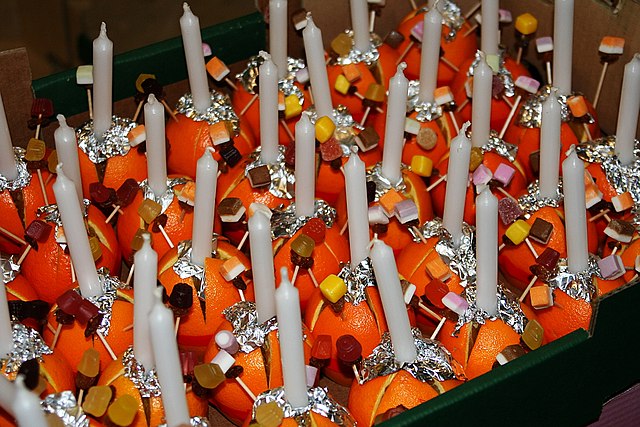Top Qs
Timeline
Chat
Perspective
Christingle
Symbolic Christian object From Wikipedia, the free encyclopedia
Remove ads
A Christingle is a symbolic object used in the Advent, Christmas, and Epiphany services of many Christian denominations. It symbolises the birth of Christ, the Light of the World.[1] A modern Christingle is made from a candle in an orange (representing the light and the world respectively) which is typically decorated with a red ribbon and sweets or dried fruit. It has been a feature in Moravian churches across the United Kingdom since before the World Wars. As members of Moravian churches moved away from their home congregations, they took the custom of Christingles with them and introduced it to other denominations. In the 1960s John Pensom adopted it as a fundraising tool for the Children's Society of the Church of England.

Remove ads
History
The history of the Christingle can be traced back to Moravian Bishop Johannes de Watteville, who started the tradition in Germany in 1747 as "an attempt to get children to think about Jesus".[2] At that time it was just a red ribbon wrapped around a candle; it is unclear how an orange came to be incorporated into the Christingle.[2]
In the intervening years, the Moravian Church spread the tradition of Christingle through their early role in the Protestant missionary movement.[3][non-primary source needed]
The custom was popularized in the United Kingdom by John Pensom in 1968.[2] He was raising funds for the charity The Children's Society.[2][4] In the 2000s, over 5,000 Christingle services, in which children are presented with Christingles, were being held in the UK every year.[2] In 2018, over 6,000 services were held for The Children's Society. Each year, Christingle raises over £1.2 million to help vulnerable young people.[5]
In 2018, The Children's Society launched its #Christingle50 campaign, which included festive services in schools and churches for the 50th year.[6]
Remove ads
Construction

A Christingle usually consists of:[1][2][4]
- An orange, representing the world
- A candle pushed into the centre of the orange, then lit, representing Jesus Christ as Light of the World
- A red ribbon wrapped around the orange or a paper frill around the candle, representing the blood of Christ
- Dried fruits and/or sweets skewered on cocktail sticks pushed into the orange, representing the fruits of the earth and the four seasons.
Other additions to the Christingle may include:
- Aluminium foil placed underneath and around the base of the candle, to prevent accidental burns from molten candle wax
- Cloves studded into the orange, as a replacement for the dried fruits and/or sweets, making it into a modern pomander
- Glow sticks were introduced at Chelmsford Cathedral in the UK in 2006 as a safer alternative to candles, due to concerns of children's hair catching on fire.[7]
Remove ads
Etymology
The name Christingle probably derives from a German dialectical word Christkindl, meaning 'Christ-child'[8][9] or 'Christmas gift'.[9] Alternatively, according to a BBC source, the name means 'Christ Light',[1] given that the orange and candle symbolise the Light of the World.
See also
References
External links
Wikiwand - on
Seamless Wikipedia browsing. On steroids.
Remove ads
